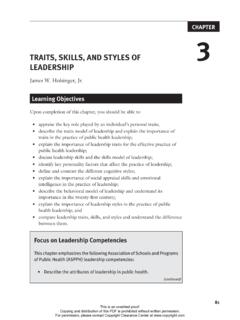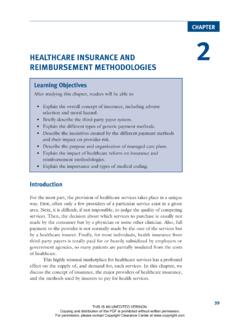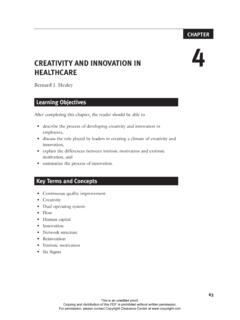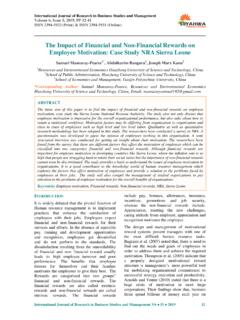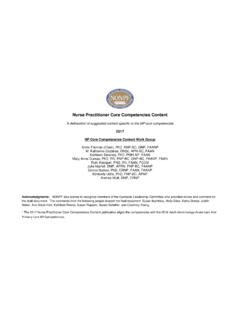Transcription of FUNDAMENTALS OF STRATEGIC PLANNING
1 77 LEARNING OBJECTIVESCHAPTER 3 FUNDAMENTALS OF STRATEGIC PLANNINGA fter you have studied this chapter, you should be able to demonstrate the ability to assess actual healthcare STRATEGIC - PLANNING problems and, using the various knowledge disciplines, develop comprehensive and practical solutions; exercise business- PLANNING techniques and demonstrate skills in professional writing and verbal communication; demonstrate a deeper understanding of the healthcare system and the mbgement of costs, quality, and access and make sound business decisions and develop a strategy for change; successfully participate in teamwork; and use critical thinking skills and create an environment that supports innovation and entrepreneurial is a hard teacher because it gives the test first, the lesson afterwards.
2 Vern LawLook before, or you ll find yourself behind. Benjamin FranklinTHIS IS AN UNEDITED VERSION. Copying and distribution of this PDF is prohibited without written permission. For permission, please contact Copyright Clearance Center at of Stragetic PLANNING in Healthcare78In t r o d u c tI o nStrategic PLANNING brings leaders and stakeholders together to position their organization for success in an environment of uncertainty. A healthcare organization engages in STRATEGIC PLANNING to reduce costs, improve quality and service, and ensure access to care. An innova-tive STRATEGIC - PLANNING process also helps an organization allocate resources more effectively to enhance the value of its services and better meet the community s healthcare US healthcare environment is changing substantially.
3 By 2011 healthcare employed percent of the US workforce and reached expenditures of $ trillion (Moses et al., 2013). Healthcare as a percentage of GDP has doubled since 1980 to percent in 2011. During the same time period, government funding for healthcare has increased from 31 percent in 1980 to 43 percent. The rate of change in an organization s market factors or technological environment determines whether an organization structure should be hierarchical or a stable environment, a hierarchical structure with centralized decision making may improve overall efficiency, provided senior leaders and managers possess sufficient knowledge and information to make informed decisions. However, in unstable environments with white-water change, the knowledge and information required for innovation must be distributed throughout multiple levels in the organization.
4 A greater flow of informa-tion combined with decentralized decision making fosters innovation. Such participatory organizational structures may be more appropriate in the current healthcare fI n I t I o nStrategic PLANNING is the process by which an organization determines its future overall direction and defines the actions that will shape it. Planners gather information about the STRATEGIC planningThe process by which an organization determines its future direction by defining the actions that will shape it and developing objectives and techniques for measuring ongoing y te r m s An d co n c e p t s Ambulatory surgery center (ASC) Balanced score card Benchmarking Dashboard Efficiency frontier Fixed cost Gap analysis Healthy People 2020 Medicare Payment Advisory Commission (MedPAC) Payer mix Safety-net providers STRATEGIC PLANNING Total cost Variable costTHIS IS AN UNEDITED VERSION.
5 Copying and distribution of this PDF is prohibited without written permission. For permission, please contact Copyright Clearance Center at 3: FUNDAMENTALS of STRATEGIC Planning79internal and external environments and have in-depth discussions about the future of the organization. They also develop organizational objectives and techniques for measuring ongoing critical components of the healthcare STRATEGIC - PLANNING model are illustrated in Exhibit and discussed in the sections that A ly sI s o f t h e en vI r o n m e n t In sI d e t h e or gA n I z At I o nInternal data focus on finances, personnel, key assets, and quality of care. A thorough analysis of internal data reveals an organization s strengths and weaknesses, both of which affect its ability to meet its STRATEGIC - PLANNING ModelOrganizational Vision and ValuesMission StatementHealthcare STRATEGIC Plan DevelopmentDevelopment of Critical Success FactorsGap AnalysisOperational PlanningEvaluation of Performance via DashboardAnalysis of the Environment Inside the Organization Organizational culture Financial resources Access to capital markets Human resources Barriers to entry Quality ValueAnalysis of the Environment Outside the Organization Economic factors Regulatory environment Patient demographics Competitor profileTHIS IS AN UNEDITED VERSION.
6 Copying and distribution of this PDF is prohibited without written permission. For permission, please contact Copyright Clearance Center at of Stragetic PLANNING in Healthcare80mI s sI o n, vI s I o n, A n d vA l u e sThomas Edison is reputed to have said that vision without execution is hallucination. An organization s mission, vision, and values provide the foundation on which its strate-gic plan is built. Consistency among mission, vision, and values and clear links among all three enhance the STRATEGIC - PLANNING process and increase the chance of performance improvement. The entire workforce must also buy into the mission, vision, and values, or execution will be difficult. cu lt u r eAn organizational culture is the shared values and beliefs that guide behavior in each organization (Pellegrin and Currey 2011).
7 An organization s distinctive beliefs provide a framework for behavior. Social values in its surrounding communities shape this behavior. For example, many people believe that access to healthcare is a right, not a privilege, and patients want to be an organization s first priority. Incorporating these social values in organizational culture is important to healthcare STRATEGIC PLANNING . Culture also guides an organization s decisions about allocating resources and estab-lishing priorities. For example, consumers and health professionals want access to the best technology available. An organization that emphasizes innovation and technological advancement needs to allocate its resources carefully to be able to fund this costly priority. If the organization promotes life-long learning, it should not cut education and training budgets at the first sign of financial stress (Pellet 2013).
8 Cr I t I c A l su c c e s s fA c t o r sAn organization s STRATEGIC plan should address improvement in five core areas:1. Healthcare quality2. Patient access3. Employee retention4. Differentiation in the market5. Alignment of resourcesSuccessful STRATEGIC PLANNING in healthcare should also include a clear connection between current projects and programs, those that are regulatory directed (such as preven-tive services and community wellness), the STRATEGIC objectives of the organization (such as evaluation of joint ventures or participation in a health system), and the measurements THIS IS AN UNEDITED VERSION. Copying and distribution of this PDF is prohibited without written permission. For permission, please contact Copyright Clearance Center at 3: FUNDAMENTALS of STRATEGIC Planning81being used to track success.
9 Tracking success will reflect organizational competency and appropriate use of information technology. Implementation of the STRATEGIC plan will require collaboration between physicians and the hospital, employee training to upgrade skill levels in some instances, annual operating goals, and a plan to update every three years. An A ly sI s o f t h e en vI r o n m e n t ou t sI d e t h e or gA n I z At I o nThe healthcare STRATEGIC - PLANNING process is subject to considerable outside control and rapid change. Federal and state legislation, physician involvement, third-party payers actions, and competitors actions all affect operations. In addition, as healthcare organiza-tions focus more on illness prevention and community wellness, they will need to consider educational, behavioral, and social interventions that have not been a part of the traditional, episodic system of medical treatment.
10 In short, healthcare organizations need to focus on the external environment and future changes to the field. By gathering information from external sources, healthcare organizations increase their likelihood of achieving information describes the market position; local demographics, competi-tors, and payers; and the local business environment. Such data are available through online databases maintained by hospital associations, regional health- PLANNING groups, the US Census Bureau, and the US Department of Health and Human e n d s I n t h e ex t e r nA l en vI r o n m e n tHospitals PLANNING strategically need to be mindful of trends influencing the direction of the healthcare environment, including the advent of accountable care organizations (ACOs), expanded insurance coverage, increased hospital participation in healthcare systems, the impact of specialty hospitals, and the rise of ambulatory surgery centers.


